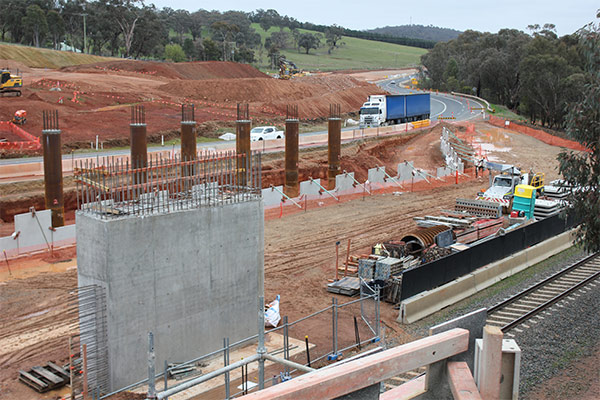One of the biggest bridge projects in regional Australia will allow bigger trucks to use bigger stretches of road in the east
Kapooka is one of Australia’s most strategic locations in more ways than one.
The Kapooka military base, near Wagga Wagga in southern New South Wales, is where new recruits to the Australian Army do their basic training before being sent all over the country.
Describing its training as ‘world-class’, Kapooka’s equipment and infrastructure is no doubt right up to date with modern warfare.
In contrast, the Olympic Highway bridge leading to the base from the south is a relic from the days of the Boer War, horses and carts, and steam trains.
Built over the main Sydney to Melbourne rail line in 1880, Kapooka Bridge is one of the chokepoints for heavier trucks wanting to travel to or from various locations in Victoria and NSW.
It’s also on a popular truck route between Melbourne and Brisbane, connecting with the Newell Highway at West Wyalong in NSW.
At present, only B-doubles grossing the standard 62.5 tonnes are allowed across the brick arch bridge, and only one B-double at a time is able to negotiate the right-angle approaches from either side.
Broken brickwork is testament to the fact that not all of them have successfully managed the tight manoeuvre.
But by about September next year this will all change when the $55 million Kapooka Bridge project is completed.
Most trucks won’t even have to change gears as they cruise the new flyover that is fast taking shape.
They will be able to pull HML (Higher Mass Limits) loads of 68 tonnes.
 |
|
Looking from the top of the first pier structure north to one of the columns for the second pier structure, with the piles for the northern abutment in the background near the current road. There is enough room for the railway line in the bottom right corner to be duplicated and for trains to carry double stacked containers.
|
On same track
There are more than 150,000 truck movements a year across Kapooka Bridge.
A lot of those are B-doubles belonging to Ron Finemore Transport, a substantial eastern Australian operator carting a lot of groceries, temperature-controlled food, fuel and bulk rural commodities among other freight.
Ron Finemore started in trucking at Wagga Wagga many years ago, but now his operation is headquartered at Wodonga on the NSW-Victorian border.
He is chair of the NSW Freight Advisory Council, and was at the Kapooka project in May for an inspection with NSW roads minister Duncan Gay and local state MP Daryl Maguire.
“B-doubles, for example carrying general freight or livestock from southern NSW to Victoria, will now experience a safer journey and greater productivity along this vital transport route,” Finemore said at the time.
“The last time I stood next to the old bridge with the Minister and local member, longer trucks had to cross over to the wrong side of the highway to negotiate the tight dog-leg bends, which was extremely dangerous.
“As a veteran of the road transport sector, I’m delighted the NSW and Australian governments are listening to the transport and freight needs of regional communities.”
The federal and NSW governments have gone 50-50 in the project, which is a flagship for the Bridges for the Bush program in NSW.
Minister Gay said: “Replacing the old crumbling Kapooka road over rail bridge and straightening its dog-legged approaches is yet another example of how the NSW and Australian governments are working together to remove notorious transport and freight pinch points in regional NSW.”
The NSW Government says the new structure will remove the only remaining weight-constrained bridge on the Olympic Highway, opening up an extra 315km for more productive trucks.
The Olympic Highway runs between Cowra in central western NSW and the Hume Highway just north of Albury on the Victorian border.
Its big new bridge will leave enough room for the main southern rail line running underneath to be duplicated, and for trains to carry double-stacked rail containers.
Check out our feature on the Kapooka project in the September issue of ATN.







